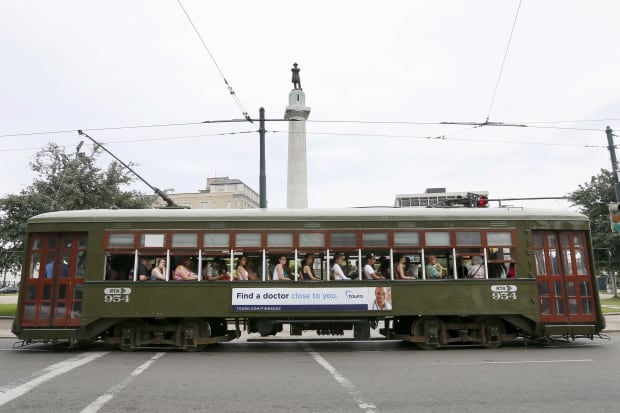New Orleans Takes Down First of Four Confederate Statues
Workers in New Orleans removed the first of four prominent Confederate monuments on Monday morning, becoming the latest Southern institution to sever itself from symbols viewed by many as a representation of racism and white supremacy.
- 10 things to know about the Confederate flag
- Alabama governor orders removal of Confederate flag
The Liberty Monument, which commemorates the white citizens who tried to topple a biracial, post-Civil War government in New Orleans, was taken away in pieces around 5:35 a.m. ET after a few hours of work.
The removal happened early in the morning in an attempt to avoid disruption from supporters who want the monuments to stay, some of whom city officials said have made death threats.

Workers dismantle the Liberty Place monument early Monday morning. The monument commemorates white citizens who tried to topple a biracial post-Civil War government, in New Orleans. (Gerald Herbert/Associated Press)
Workers who took the monument down on Monday could be seen wearing bulletproof vests, military-style helmets and scarves that obscured their faces. Police were also on hand, including officers who watched the area from atop the parking garage of a nearby hotel.
Three other statues to Confederate Generals Robert E. Lee and P.G.T. Beauregard and Confederate States of America President Jefferson Davis will be removed in later days now that legal challenges have been overcome.
“There’s a better way to use the property these monuments are on and a way that better reflects who we are,” New Orleans Mayor Mitch Landrieu said in an interview Sunday.
Heated debate since black churchgoers killed
Nationally, the debate over Confederate symbols has become heated since nine parishioners were killed at a black church in South Carolina in June 2015. South Carolina removed the Confederate flag from its statehouse grounds in the weeks after, and several Southern cities have since considered removing monuments. The University of Mississippi took down its state flag because it includes the Confederate emblem.

New Orleans Mayor Mitch Landrieu called the Liberty Monument, the first to come down, the most offensive of the four tributes. (Gerald Herbert/The Associated Press)
New Orleans is a predominantly African-American city although the number of black residents has fallen since Hurricane Katrina drove many people from the city in 2005.
In 2015, the city council, with a majority of black council members, voted 6-1 to approve plans to take the statues down, but legal battles had prevented the removal until now, said Landrieu, who proposed the monuments’ removal. Landrieu was elected twice as the mayor of New Orleans with overwhelming support from the city’s black residents.
People who want the Confederate memorials removed say they are offensive artifacts honouring the region’s slave-owning past. But others call the monuments part of the city’s history and say they should be protected historic structures.
Robert Bonner, 63, who said he is a Civil War re-enactor, was there to protest the statue’s removal.
‘If there was ever a statue that needed to be taken down, it’s that one.’
– New Orleans Mayor Mitch Landrieu
“I think it’s a terrible thing,” he said. “When you start removing the history of the city, you start losing money. You start losing where you came from and where you’ve been.”
Monuments ‘an aberration,’ says mayor
Landrieu said the memorials don’t represent his city as it approaches its 300th anniversary next year. The mayor said the city would remove the monuments, store them and preserve them until an “appropriate” place to display them is determined.

Charles Lincoln speaks during a candlelight vigil at the statue of Jefferson Davis, which will soon be taken down, in New Orleans early Monday. New Orleans will become latest Southern body to divorce itself from what some say are symbols of racism and intolerance. (Gerald Herbert/The Associated Press)
“The monuments are an aberration,” he said. “They’re actually a denial of our history and they were done in a time when people who still controlled the Confederacy were in charge of this city and it only represents a four-year period in our 1,000-year march to where we are today.”
The first memorial to come down, the Liberty Monument, was an 1891 obelisk honouring the Crescent City White League.
Landrieu has called the Liberty Monument “the most offensive of the four” and said it was erected to “revere white supremacy.”
“If there was ever a statue that needed to be taken down, it’s that one,” he said.

Dana Farley, of New Orleans, participates in a candlelight vigil at the statue of Jefferson Davis in New Orleans early Monday. (Gerald Herbert/The Associated Press)
The Crescent City White League attempted to overthrow a biracial Reconstruction government in New Orleans after the Civil War. That attempt failed, but white supremacist Democrats later took control of the state.
An inscription added in 1932 said the Yankees withdrew federal troops and “recognized white supremacy in the South” after the group challenged Louisiana’s biracial government after the Civil War. In 1993, these words were covered by a granite slab with a new inscription, saying the obelisk honours “Americans on both sides” who died and that the conflict “should teach us lessons for the future.”
The Liberty Monument had been the target of a previous lawsuit after the city removed it from a location on the main downtown thoroughfare of Canal Street during a federally-financed paving project in 1989. The city didn’t put the monument back up until it was sued, and moved the monument to an obscure spot on a side street near the entrance to a parking garage.
- Dylann Roof, South Carolina church gunman, given 9 life sentences for murder
- Confederate flag comes down at South Carolina capitol
?

A streetcar passes by the 18-metre tall monument to Confederate General Robert E. Lee that towers over a traffic circle in New Orleans. It is one of the four controversial monuments to be removed. (Jonathan Bachman/Reuters)